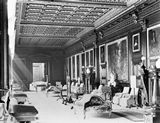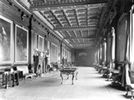 |
||||||||
| Hamilton Palace (site), Hamilton, South Lanarkshire | ||||||||
 © RIAS |
View of long gallery from east |
|||||||
|
This photograph of about 1890 shows some two-thirds of the gallery looking from a point in front of the throne across shafts of sunlight towards the entrance in the west end wall. In the north or main picture wall (right) the pair of black marble chimneypieces and the Rubens painting are clearly visible, while the gallery chairs and sofa are shrouded by dust covers. In the centre of the west end wall is the pedimented architrave (surround) of the grand entrance doorway, wrought from black marble and framed by columns of green porphyry, discernible here against the dark background, a composition that was evidently unique in Europe. Beyond, through the open door, is the top-lit and balconied tribune which forms a linking ante-chamber between the gallery and the new dining room further to the west. The 10th Duke's passion for marble, especially pure black Galway marble, was in evidence throughout the palace, and his deep interests in Egyptology gave him a special taste for porphyry, a rare and precious crystalline rock of Egyptian and Numidian (Tunisian) origin. In addition to the door-shafts of green porphyry, red porphyry busts of Augustus and Tiberius flanked the ambassadorial throne, purple porphyry was used for table tops, and two columns of black porphyry, also associated with the gallery doorway, had ultimately derived, via a church in Viterbo, from the Basilica di Semproneo in Ancient Rome. |
||||||||
|
|
|
|
|
|
|
|
|
|
|
|
|
|
|
|
|
|
|
|
